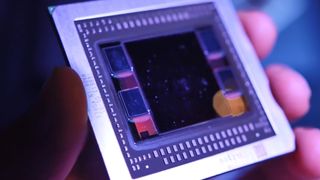Samsung kicks off HBM2 production for use in next-gen graphics cards

Samsung has announced that it is has begun mass producing a 4GB DRAM package based on the second generation High Bandwidth Memory (HBM2) interface. Samsung claims that it's seven times faster than the current DRAM performance limit, which means faster responsiveness for parallel computing, machine learning, and most importantly for gamers: graphics rendering.
The new DRAM package features 256GBps of bandwidth (twice that of a HBM1 DRAM package, like the memory used in AMD's Fury GPU). Compared to a 4GB GDDR5 DRAM chip, that's a seven-fold increase, and it has double the power efficiency.
"By mass producing next-generation HBM2 DRAM, we can contribute much more to the rapid adoption of next-generation HPC systems by global IT companies," said Sewon Chun, senior vice president or Memory Marketing at Samsung. "Also, in using our 3D memory technology here, we can more proactively cope with the multifaceted needs of global IT, while at the same time strengthening the foundation for future growth of the DRAM market."
Samsung also plans to produce 8GB packages within 2016, which it says will offer designers space savings of more than 95 percent compared to using GDDR5 RAM. This opens the door for smaller graphics hardware for smaller form factor devices. We'd be okay with a mini-ITX successor to the Nvidia 980 Ti / AMD R9 Fury X. How about you?
Reports last fall indicated Nvidia will be sourcing HBM modules from Samsung, which hopefully means we'll be hearing more about Pascal, and AMD's follow-up to the Fury, in the near future.
The biggest gaming news, reviews and hardware deals
Keep up to date with the most important stories and the best deals, as picked by the PC Gamer team.

Nvidia's upgrading GeForce Now's $10 tier with 1440p and Ultrawide resolutions, but the only extra Ultimate users get is a new 100-hour play limit

Intel CEO sees 'less need for discrete graphics' and now we're really worried about its upcoming Battlemage gaming GPU and the rest of Intel's graphics roadmap
Most Popular







